Tradescantia Nanouk is not difficult to care for if you keep in mind its basic needs and some of its special quirks.
All Tradescantias are easy to grow, colorful, and very beautiful and are beloved as houseplants the world over.
But, Tradescantia Nanouk is special: pink, purple, green, and white stripes create a stunning pattern on its leaves, looking like each leaf has been brushed by a talented painter.
Tradescantia stems are thick and chunky, providing sturdy support to rounded, fuzzy thick leaves. Small, charming pink buds and white and yellow flowers show up in spring and summer.
Tradescantia “Nanouk” branches grow upright. It takes a very long time and excellent growing conditions for this lovely plant to start trailing.
Tradescantia “Nanouk” has been created in 2012 by plant scientists in the Netherlands to be more hardy, vigorous, and beautiful. They certainly succeeded!
Table of Contents
Tradescantia Nanouk Care
Tradescantia Nanouk needs bright indirect light to keep the vivid colors of its leaves, well-draining soil using orchid bark, perlite, and some horticultural sand to avoid root rot, and watering from below so that the leaves do not rot. Water every 2-3 weeks. The temperature should be within 60-75°F (16-24°C). A humidity level of 40-60% is ideal. Fertilize monthly using a balanced fertilizer diluted to half-strength in spring and summer.
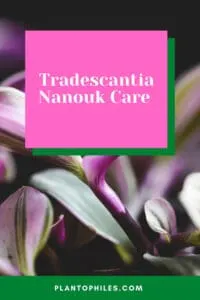
Tradescantia nanouk Care
Soil
Like other Tradescantias, Tradescantia “Nanouk” likes free-draining soil that never allows roots to be wet.
You can use any good-quality commercial soil mix for houseplants, but your plant would benefit from adding a bit of orchid bark, perlite, and some horticultural sand.
It is very important that the soil is light as dense soil can cause root rot. You can learn to make your own excellent potting mix.
Watering
Watering your Tradescantia Nanouk the right way is the biggest difference between having a happy, thriving plant and, well, a sad, yellowing one with rotting leaves.
Because of its dense growth and closely furled leaves, it is not a good idea to water your Nanouk from above. It is very likely that the water trapped in the leaves will cause the leaves to rot.
You can try to water it very carefully from above by pouring water into the soil, avoiding touching the leaves.
Also, you can water the plant by soaking the entire pot in tepid water for an hour or so and then letting the excess thoroughly drain from the hole in the pot on a drip tray.
Make sure that your Tradescantia “Nanouk” actually needs watering by touching the soil with your fingers.
If the first few centimeters (an inch or so) of soil are dry, give it a good soaking. Otherwise, wait for a few days.
During its active growing season in Spring and Summer, water your plant every two to three weeks.
You will see that it needs much less water in the fall and winter. Also, keep in mind that plants getting northern light need less watering.
Light
Tradescantia “Nanouk” thrives in bright, indirect light, so if you can, place it near the north or east-facing window.
If your plant is facing north, it will get less light so it will need less water.
You will know that you are not giving your plant enough light if it starts looking leggy or its lovely colors start fading away and turning basic green.
Too much light will turn the leaf edges crispy. Just the right amount of light will make your Tradescantia start forming buds and blooming in the growing season.
Never place your Tradescantia in full sun.
Temperature
Tradescantia Nanou” grows best in temperatures between 60-75°F (16-24°C).
The night temperatures should not fall below 50°F (10°C).
Keep the temperature consistent and never place your plant near a heat source or draft.
Humidity
Keep a humidity level of 40-60% for Tradescantia Nanouk.
A humid environment is ideal for making your Tradescantia “Nanouk” happy and thriving.
It is fairly easy to give it all humidity it needs. Many homes these days use humidifiers. If you do, your plant will thank you.
You can place your Tradescantia pot on a tray of pebbles filled with water.
You can also place your plant on the bathroom window, where it will not be sprayed by the shower but will enjoy the steam from your bath. As a bonus, your bathroom will look luxurious.
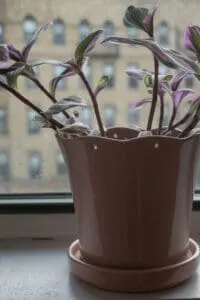
Tradescantia nanouk thrives in a humidity between 40-60%
Fertilizer
Tradescantia Nanouk is a vigorous grower and in the growing season in spring and summer benefits from a monthly feeding using a balanced fertilizer diluted to half-strength.
If you prefer the organic route, make a compost tea by soaking your compost in a bucket of water for a few days.
Drain the resulting ‘tea” and dilute it in half. Use this organic fertilizer to feed your Tradescantia and any other house plant that needs feeding.
Stop feeding after the growing season ends.
If you completely neglect to feed your Tradescantia ‘Nanouk”, it will not be worse for it and you will probably not notice the difference.
Never fertilize your plant right after repotting.
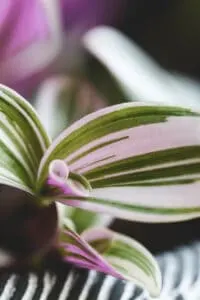
Feed Tradescantia nanouk monthly in spring and summer
Repotting
Tradescantia “Nanouk” is a vigorous grower and it will probably fill the pot with roots in one growing season.
It means that you should re-pot it once a year or so. Plant it in a container one size larger than before.
In fall and winter, leave your plant alone to rest.
Because your plant is such a fast grower, you might need to re-pot it more often. Here are the signs that it is time for it:
- The roots are growing out of the drainage hole;
- You can see the roots circling the soil inside the pot.
Check your plant during the growing season by lifting it gently out of the pot. If it is easy to lift the whole root ball and the soil, it probably has more roots than soil. It means it is time for repotting, fresh soil, and a bigger pot.
Give your Tradescantia a good soaking after repotting.
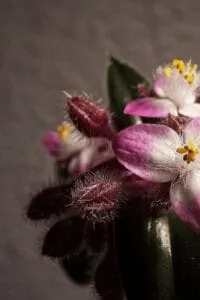
Tradescantia nanouk is a vigorous grower
Pruning
You can prune your Tradescantia “Nanouk” at any time by pinching new growth or cutting back its branches. Regular pruning will make it grow denser and bushier.
Use sharp, sterilized garden cutters to pinch new growth or branches, or use your fingers.
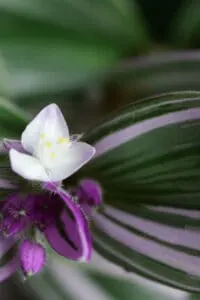
Tradescantia nanouk is easy to care for
Propagation
Propagate your Tradescantia ‘Nanouk” by planting the branch cuttings or pinched new growth.
You can place the cuttings back into the same pot, around the rim. It will make the plant look bushier and the cuttings will grow happily in the familiar environment.
You can also place cuttings in water until they grow roots.
Trim the first few pairs of leaves before placing the cuttings in a jar half-filled with water (use distilled water if your water is hard.) Make sure no leaves are in the water, just the stem.
Let the roots grow until they are an inch or so long before planting your cuttings in the soil. If you let your roots grow in water too long, they will become too soft and will get crushed by the soil
When propagating your cuttings in the water, you will be able to see when the new roots are ready to be planted.
You can also propagate your cuttings in the soil. Just stick each cutting in a small growth pot and water it well. You can expect the roots to grow in a few weeks.
Plant three or four newly rooted cutting in the same pot to make the new plant look bushier.
Nanouk stems are fairly thick so they might take longer to root. Just be patient.

Tradescantia nanouk has beautiful green, white and pink foliage
Blooms
If you provide your Tradescantia “Nanouk” with ideal conditions, it will reward you with charming little blooms.
The buds are purple-pink, opening into white or pink flowers, which may bloom throughout the growing season – from spring to the end of summer.
Some really healthy, strong plants will continue to bloom indoors throughout the year.
Growth
Tradescantia “Nanouk” grows vigorously, producing brightly colored leaves on thick branches.
Bright, indirect light allows this plant to produce more vivid patterns on the eaves and thicker, denser growth.
If the plant does not get enough light, it becomes leggy, resembling other trailing Tradescantias. Some growers prefer it, but they lose colored leaves as a price.
Tradescantia “Nanouk” will develop trailing branches in time, as the branches grow and the heavy leaves pull the branches down.
Common Problems with Tradescantia Nanouk
Tradescantias are in general resistant to pests and Nanouk has been developed to be even more resilient than its relatives. But, It is not completely immune, especially if the growing conditions are less than ideal.
Mealybugs
If the growing environment is warm and dry, mealybugs can show up. You will know you have a mealybug infestation if you see sticky honeydew on the branches and leaves. This honeydew attracts insects and fungus. Clean the honeydew with a cotton ball soaked in alcohol or, for the organic solution, spray the plant with neem oil.
Spider mites
A dry environment is also conducive to spider mites infestation, especially if the plant is weak and allowed to dry out. Spraying your plant with neem oil will get rid of spider mites. You can prevent your plant from being infected with mites by increasing the humidity and leaving more space between plants to allow air circulation.
Root and leaf rot
Overwatering, especially if the soil is too dense, will cause root rot.
Watering the Tradescantia “Nanouk” from above might cause a leaf rot if the water gets trapped in leaves.
Prevention is always better than having to deal with plant problems. Provide your Tradescantia with a warm, humid environment with bright, indirect light and it will live happily and trouble-free.
Tips for growing a healthy, vigorous Tradescantia “Nanouk”
- Keep your Tradescantia in bright, indirect light to encourage bright color of its leaves and compact growth;
- Soak your plant from below to avoid leaf rot. It is always better to give the plant one good soaking with the excess water draining thoroughly than frequent watering;
- Make sure the soil you use is free-draining and light;
- In the fall and winter, water your plant less and do not fertilize in at all;
- Keep the humidity levels between 40 to 60 percent.
Frequently Asked Questions about Tradescantia Nanouk Care
Why is my Tradescantia Nanouk losing its colors?
Your Tradescantia Nanouk is not getting enough light. Place it near the eastern or northern window, in bright indirect light, and the colors will improve.
The leaves of my Tradescantia Nanouk are turning yellow and dropping. What am I doing wrong?
You are watering your plant from above and some of the water is being trapped in the leaves, causing them to rot. Instead, soak the entire pot in tepid water once a month or so, when the top of the soil dries out. Let the excess water drain thoroughly through the drainage hole in the pot.
Is the Tradescantia Nanouk toxic?
Tradescantia Nanouk is toxic to pets and children. Make sure you place the pot out of their reach.
My Tradescantia Nanouk looks miserable and it might be dying, what can I do?
You might be able to save your plant by taking it out of the pot, washing away all the old soil, and cutting away all the rotting, damaged roots. Plant the Tradescantia in fresh, free-draining soil and put it on a window sill in a humid, bright light, such as a bathroom window sill. If you have enough healthy roots left, the plant has a chance of recovering. Prevent this from happening by using free-draining soil and water the plant only when the top inch of the soil is dry.
Why are the leaves of my Tradescantia Nanouk dry and crispy at the edge?
Your plant is getting too much light or is in direct sun. Move it to a spot with indirect light and provide enough humidity. You can place the pot on a tray filled with wet pebbles.
Can I place my Tradescantia Nanouk outside on the porch?
Your Tradescantia is used to indirect light and protected indoor living. If you want to place it outdoors, put it in a light shade, never in direct sun. Make sure it never gets cold or sit in a draft.
Conclusion
Tradescantia Nanouk is a very beautiful plant that will give you years of pleasure, colorful leaves, and even tiny white flowers if it is really happy.
It requires very little care, as long as you give it plenty of indirect light, humidity, and free-draining soil. Water only when it needs it, once a month or even less in the winter.
The more indirect light your Tradescantia has, the more stunning its colorful leaves will become. Make it into a spectacular décor for your bathroom by placing it at the bathroom window.
Its compact growth makes it even suitable for a dining table or a side table in the living room as long as there is enough light.
You can make wonderful gifts to your friends by propagating your plant’s new growth or branch cuttings. When you are trimming your plant, do not throw out the cuttings.
Plant them in water or soil until the roots grow and place four or five rooted cuttings in a nice pot for a wonderful gift.

Daniel has been a plant enthusiast for over 20 years. He owns hundreds of houseplants and prepares for the chili growing seasons yearly with great anticipation. His favorite plants are plant species in the Araceae family, such as Monstera, Philodendron, and Anthurium. He also loves gardening and is growing hot peppers, tomatoes, and many more vegetables.


